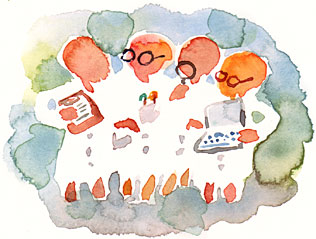Sink/Float Experiment
A science
demonstration which is safe, (almost) always works, and allows kids to be
involved. Teacher: Shirley, what do you think this crayon will do in the water?
Precocious 4 year old Shirley: Dissolve.
Objectives
Children ages 5 and up can give the materials
that the objects are made out of Cog. I
Children between the ages of 4-5 can help with problem solving: able to detect
properties of objects in water will sink or float Cog. I
Children between the ages of 3-4 can use weight to describe an object Cog. I
and children 2-3 can give use of objects by pointing or gesturing Cog. I
And children 1-2 years can identify simple objects Lang. IB
Materials
Large fish bowl;
familiar objects such as apple, banana, wooden block, small glass, bottle with
lid, scissors (metal), paper cup, sponge, plastic toy, wooden toy, rubber ball,
pencil, pen, rock, plastic fork, shell, etc. with easily identifiable
composition, i.e. wood, food, metal, plastic, stone. (Don't use crayons. Wax
crayons float, but pressed crayons sink. It's confusing.)
Procedures
LANGUAGE TO EMPHASIZE:
Sink, float, top, bottom, wet, dry.
1. Seat children in a semi-circle around a small table. Place water on the
table. Have all of the objects in a bag.
2. Choose one child to pick an object out of the bag. Ask the other children to
name the object, describe its use, and identify the material(s) it's made of.
3. Ask the group to guess whether the object will sink or float. Take a vote
and count. Have the child drop the object into the bowl. See if it sinks or
floats.
4. Proceed in this fashion, dividing the things that have already been tested
into two groups on the table. Help children define classifications by reviewing
the compositions of each group of objects. Discuss and compare composition of
tested objects with the new object drawn from the bag, e.g. "This
toothpick is made of wood and it floated in the water. This block is made of
wood, too. What do you think the wooden block will do in the water?"  Variations:
1. 1) Draw a picture of
the fish bowl, coloring the water blue. Have identical set of objects to those
tested. After observation of buoyancy of object, have children glue identical
object to picture either at the water line (float) or bottom of bowl (sink).
Hang picture on wall for all to see. This can be done as individual pictures or
a group picture.
2. 2) Use medicine
containers with kids (or baby food jars) and items from the kitchen – sugar,
salt, coffee rounds, spices, etc. Put
water in each container, add some substance, and shake. The substance may sink,
float, or dissolve. Questions or Comments about this Lesson Plan? Please write us here. (Be sure to mention the name of the Lesson Plan in your email Subject line.)
|